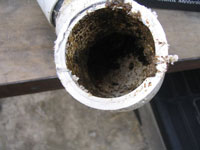Biofilm in waterlines

Micro-organisms thrive in the presence of water and nutrients. The movement of water creates an unstable environment for survival. Consequently, micro-organisms have evolved in a manner that allows them to adhere to a substrate with great tenacity. When they find a suitable surface they attach themselves and then initiate multiplication. Growth can be rapid, with new cells attaching to each other as well as extending laterally across the surface. This creates a "woven matrix colony" in which other organisms can grow and develop. This matrix is often referred to as “slime” or “biofilm”.
There are a variety of nutrient sources within water systems. These include scale, sediment, corrosion products and other trapped organic and inorganic matter. The movement of the water ensures that colonies receive a constant supply of nutrients. When this is combined with specific temperature conditions, which are often found inside heating systems such as calorifiers and heat exchangers, the perfect conditions exist for rapid microbial growth. The population will predominantly consist of aerobic (oxygen seeking) and anaerobic (living without oxygen) bacteria. There will also be traces of fungi and algae, which in turn support predatory organisms such as protozoa and metazoa. These predatory organisms ingest bacterial cells for food.
The control of biofilm within water systems is essential. As climate conditions change, cold water systems are increasingly reaching temperatures that are conducive to biofilm growth.
Biofilms are costly
Their presence poses a constant threat to health. They have an impact on energy requirements of a system, cause corrosion and increase frictional drag.
Energy costs
Biofilm is 85-95% water. It acts as an insulating layer of stagnant water. As water has one fifth the thermal conductivity of carbonate scale, a 1mm biofilm has the insulating properties of a 5mm scale coating. This results in greatly reduced heat transfer efficiency at heat exchange surfaces.
Corrosion
Anaerobic sulphate reducing bacteria can form and live in biofilm. These produce sulphuric acid which will corrode pipes and can result in leaks. Anaerobic iron-oxidizing bacteria can cause serious corrosion to pipes, leading to high maintenance costs and loss of production.
Frictional drag
As a biofilm proliferates in a pipe, it reduces the diameter. This causes frictional drag, pressure drops and a need for increased pumping power. This results in reduced efficiency and increased costs.
Chlorine dioxide
Using AQQUON as a part of a water hygiene management program will help to wash of organic matter and possibly eliminate biofilm andmaintain a safe, efficient and clean water system.
